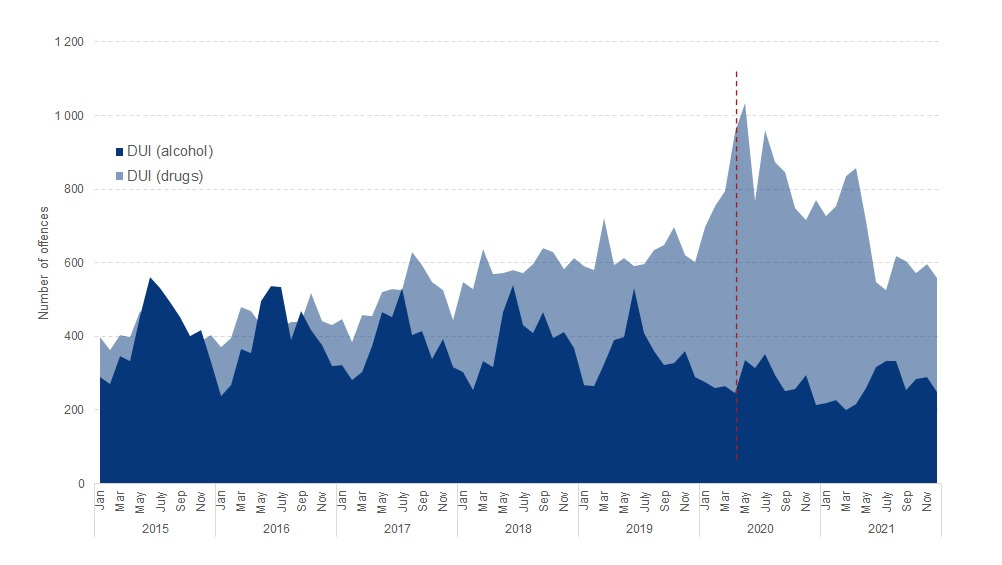
By Mika Sutela
Empty roads inspired drivers to speed
Serious speeding has increased on Finnish roads during the COVID-19 time. If we look at number of monthly causing a serious traffic hazard offences (i.e. about 50km/h speed over the limit) reported to the police in Finland in recent years, we can notice that there was a spike immediately in the beginning of the pandemic, in April 2020. The number of these offences has been quite high from March to August/September in 2020 and 2021. Monthly average is 480 offences for the years 2020–2021, and 339 for 2017–2019. Thus, there was an increase of 42 percent.
Driving under the influence of drugs has increased
In 2020, there were about 370 police recorded driving under the influence (DUI) offences per 100,000 inhabitants in Finland. Nowadays, about half of the all police recorded DUIs in Finland are drug-based cases. Driving under the influence of drugs has become more and more common in Finland in recent years. The number of police recorded drug-based DUIs has increased constantly from the beginning of the 2010s. In 2020, drug-based DUIs increased in the beginning of the pandemic but decreased later to the ’normal’ level so that there is not any strong change in the number of those offences between the COVID years and pre-COVID time.
In the figure below, the numbers of monthly alcohol- and drug-based DUI offences reported to the police in Finland in 2015–2021 are presented. The dotted vertical line is showing the beginning of the pandemic in March 2020. In 2020–2021, monthly average of alcohol-based DUIs decreased about 27 percent and, in turn, drug-based DUI cases increased about 30 percent from the years 2017–2019.
Number of serious i.e. aggravated alcohol-based DUIs (BAC at least 1.2‰) has remained rather constant even during the pandemic but with regard to the ’normal’ DUI, traditional summer peaks has not appeared.

No evidence-based explanations
There is no reliable, evidence-based information on causes of the Finnish traffic crime situation. In COVID-19 time, there have been empty roads, closed bars and restaurants, and only few events. People have used more their own vehicles instead of public transport. Traffic enforcement was relatively more efficient than before. The police have been focusing their traffic surveillance on detecting impaired drivers and serious speeders.
In the coming years, traffic will hopefully be more strongly than before a part of intelligence-led policing as there has recently been published Programme for police traffic enforcement and traffic safety for 2021–2030 by the Ministry of the Interior, Action and development plan for police traffic enforcement and traffic safety 2022–2030 by the National Police Board of Finland and, in addition, Traffic safety strategy 2022–2026 by the Ministry of Transport and Communications.
At the NSFK Research Seminar, Mika gave a presentation about development of serious traffic offence rates and road traffic deaths in Finland during the COVID-19 pandemic.
Mika Sutela is an information analyst at National Police Board of Finland and associate professor of empirical criminal justice research at University of Eastern Finland. His research interests include e.g. traffic crimes, policing and judicial decision-making. @SutelaMika (official account), @mksutel
